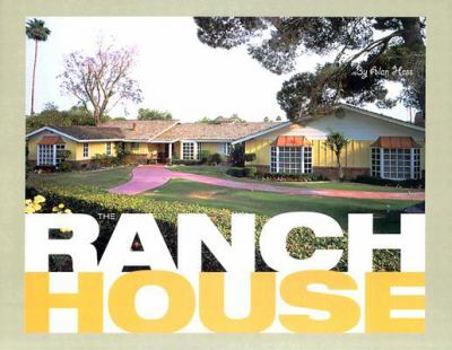The Ranch House
Select Format
Select Condition 
Book Overview
The trend is unmistakable. The Ranch-style house, a phenomenal success in the '40s, '50s, and '60s, is making a comeback. Like the enthusiastic embrace of Modern-style houses in the past decade, the Ranch house today is being snatched up and restored all across suburban America, while longtime owners are rediscovering what seduced them in the first place. Now Alan Hess, one of the country's leading authorities on the 20th-century American home, offers the definitive look at the Ranch house as he guides readers on a tour of more than 30 iconic examples, all photographed especially for this book. With L- or U-shaped floor plans and sliding glass doors that provide direct access to the patio from the living area, the Ranch house is ideal for an indoor/ outdoor lifestyle and great for families, qualities that made it so appealing in its early days. Now, as this book illustrates, with baby boomers reclaiming the design aesthetic of their youth and a younger generation welcoming the warm and casual spirit of the Ranch, it's no surprise that this most populist of house styles is popular once again.
Format:Hardcover
Language:English
ISBN:0810943468
ISBN13:9780810943469
Release Date:January 2005
Publisher:Harry N. Abrams
Length:240 Pages
Weight:3.20 lbs.
Dimensions:1.0" x 9.8" x 12.0"
Age Range:13 years and up
Grade Range:Grade 8 to Postsecondary
Customer Reviews
3 ratings
Gorgeous photos, wonderful introduction
Published by Thriftbooks.com User , 15 years ago
I enjoyed the photos in this beautiful book the moment I received it, and a year later I continue to enjoy examining the photos. I am currently reading all of the text in the book. The introduction is wonderful and informative, but not too academic. Hess begins with an explanation of the precursors to the ranch home, then discusses the beginning of the ranch movement, and ends by discussing this style's hay day and its demise in the 70s. I personally prefer the spreads of the custom homes, and found the photos of the lower end homes a little blah. There is one photo of the side of the house and dirt. No landscaping. I was confused by this at first, but I think Hess is trying to give the reader a full picture of the ranch style -- both the large custom homes like the May/Wagner home (LOVE IT) and the smaller tract homes built for blue collar families (communities which still thrive).
Not quite comprehensive, but a good survey.
Published by Thriftbooks.com User , 16 years ago
The first half of the book quite thoroughly describes the evolution of the traditional working ranch home into the contemporary suburban family compound. Especially interesting is the information about the beginnings of suburban subdivisions in general. While Hess limits his focus to a handful of California and Arizona communities, the stories of these communities were doubtless replicated in other cities all the way to the east coast. The only negative, really, is that the photo spreads in the second half of the book seem to be focused more on custom homes. With the focus of the first section being more on mass-produced tract homes, I would like to have seen an equal focus on these communities in the second half as well. I would have also liked to see more contemporary examples, as there are only one or two contemporary models showcased, with many examples of the rustic style. Overall, a very informative look at the evolution of ranch homes in the mid-century American west.
The joys of one-level living
Published by Thriftbooks.com User , 20 years ago
Another beautiful Alan Hess architectural history that deserves to become the standard work. The book is in two parts, in the first sixty-eight pages he writes a readable and interesting history of this very popular housing concept and being popular it was looked down on by the architectural elite and many critics. The second part (147 pages) is a pictorial study of twenty-six ranch houses photographed by Noah Sheldon. It is Sheldon's photos that makes the book come alive for me. With one photographer taking all the color photos there is a consistency of composition and color values and these 230 photos really work, with exteriors and interiors showing structural detail and the use of space. He manages to make the work of Cliff May, William Wurster or Harwell Hamilton Harris really sparkle plus Hess has written comprehensive captions to all these images, another refreshing plus for a highly visual book. The design and production can't be faulted though to really make it perfect I would have liked to see floor plans of the twenty-six houses. By the nature of the ranch house, on one floor and no need for second floor supporting walls, rooms could meander in any direction and the leading architects of the style certainly took advantage of this. The back pages have a bibliography and index. I think Hess has written an excellent survey of this past popular house style and it will appeal to anyone interested in domestic architectural design. ***FOR AN INSIDE LOOK click 'customer images' under the cover.






